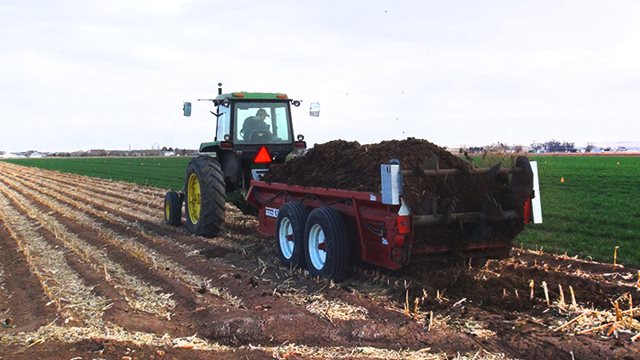Managing the Application of Manure
Sep 10, 2018

With proper management, livestock manure can be a valuable resource for crop nutrients, while also protecting our environment at the same time.
Step 1: Use soil test and cropping information to determine nutrients needed.
Manure should not be applied at rates exceeding nitrogen requirements. Where practical, manure should be applied based upon phosphorus needs. In general, for soils testing 150-300 lb/Acre P, add no more than crop removal, and for soils testing > 300 lb/Acre P, do not apply manure.
Step 2: Determine the nutrient content of manure through manure analysis.
Ideally, manure should be sampled just prior to land application. Collect and submit a representative manure sample from pooled and thoroughly mixed sub-samples. Keep samples cooled or frozen prior to submitting for analysis.
Step 3: Determine plant available manure nutrients.
Remember that liquid portions of manure are most susceptible to loss. Stockpiling manure uncovered and exposed to rainfall, can result in significant reductions in nitrogen and potassium content. Calculate plant available nitrogen (PAN) by using nitrogen available from both ammonium and organic forms: (NH4+ - N) + (Available Organic N) = Plant Available N (PAN). Most all the phosphate (P2O5) and potash (K2O) applied in manure is available to the crop in the first year. Although the organic fraction of nitrogen is stable, further losses of nitrogen can occur from the unstable ammonium fraction, and will vary based on handling and application methods:

Step 4: Measure and calculate actual amount of manure applied per acre.
Apply manure as evenly as possible trying to avoid ponding, runoff, etc. To calibrate, place three or more plastic sheets in the path of the manure spreader. Calculate the amount of manure applied by catching it on the plastic sheets, and then weighing.

Step 5: Create a Nutrient Management Plan
Utilize soil test and cropping information into a field-by-field plan for nutrient applications from all nutrient sources including manure, and then assemble a plan for specific manure application with timing and amounts needed for each field, adjusting the plan for each growing season.
Submitted by Suretech Laboratories
All analytical work is conducted professionally and in accordance with applicable standard laboratory practices and this data reflects SureTech’s best attempt to generate accurate results for the specific samples(s). Because of factors outside of SureTech’s control, such as weather, product application and any other factors, results to be obtained, including but not limited to yields, financial performance or profits, cannot be predicted or guaranteed by SureTech. © 2016 Winfield Solutions, LLC
Step 1: Use soil test and cropping information to determine nutrients needed.
Manure should not be applied at rates exceeding nitrogen requirements. Where practical, manure should be applied based upon phosphorus needs. In general, for soils testing 150-300 lb/Acre P, add no more than crop removal, and for soils testing > 300 lb/Acre P, do not apply manure.
Step 2: Determine the nutrient content of manure through manure analysis.
Ideally, manure should be sampled just prior to land application. Collect and submit a representative manure sample from pooled and thoroughly mixed sub-samples. Keep samples cooled or frozen prior to submitting for analysis.
Step 3: Determine plant available manure nutrients.
Remember that liquid portions of manure are most susceptible to loss. Stockpiling manure uncovered and exposed to rainfall, can result in significant reductions in nitrogen and potassium content. Calculate plant available nitrogen (PAN) by using nitrogen available from both ammonium and organic forms: (NH4+ - N) + (Available Organic N) = Plant Available N (PAN). Most all the phosphate (P2O5) and potash (K2O) applied in manure is available to the crop in the first year. Although the organic fraction of nitrogen is stable, further losses of nitrogen can occur from the unstable ammonium fraction, and will vary based on handling and application methods:

Step 4: Measure and calculate actual amount of manure applied per acre.
Apply manure as evenly as possible trying to avoid ponding, runoff, etc. To calibrate, place three or more plastic sheets in the path of the manure spreader. Calculate the amount of manure applied by catching it on the plastic sheets, and then weighing.

Step 5: Create a Nutrient Management Plan
Utilize soil test and cropping information into a field-by-field plan for nutrient applications from all nutrient sources including manure, and then assemble a plan for specific manure application with timing and amounts needed for each field, adjusting the plan for each growing season.
Submitted by Suretech Laboratories
All analytical work is conducted professionally and in accordance with applicable standard laboratory practices and this data reflects SureTech’s best attempt to generate accurate results for the specific samples(s). Because of factors outside of SureTech’s control, such as weather, product application and any other factors, results to be obtained, including but not limited to yields, financial performance or profits, cannot be predicted or guaranteed by SureTech. © 2016 Winfield Solutions, LLC